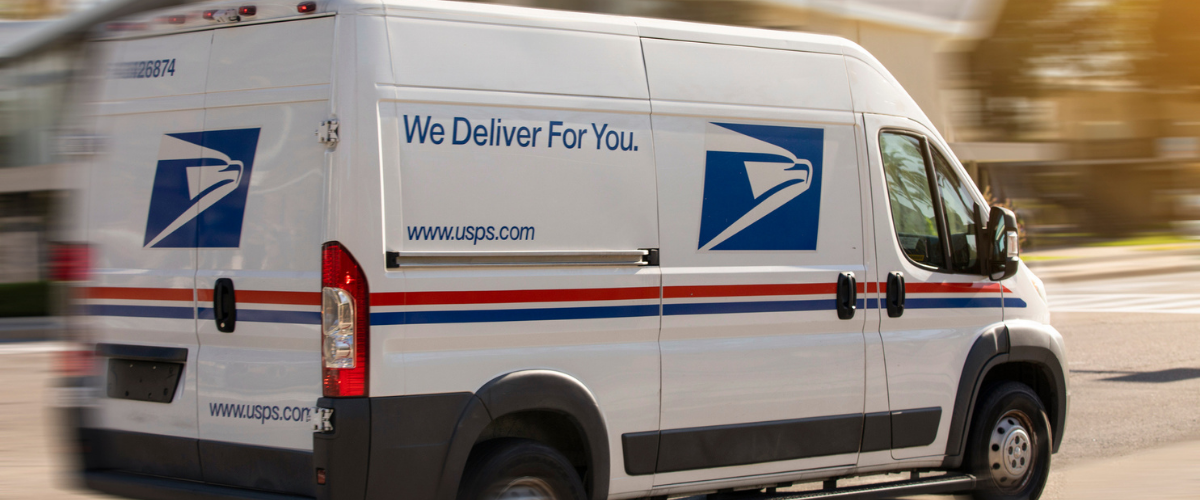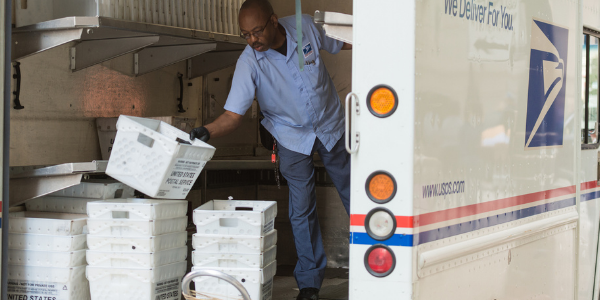USPS® Mail Slowdown and Delays - and HOW TO AVOID THEM!
|
March 4, 2022
|

What you need to know about the USPS® mail slowdown and how to avoid the delays...
On Oct 1, 2021, the U.S. Postal Service announced that the delivery standard for First-Class Mail® would get longer, not shorter. In the past, First-Class Mail took between one to three days depending on destination. Now, the Postal Service will have up to five days to deliver those important mail pieces anywhere in the United States. That’s everything from letters, postcards, envelopes, invoices, bills, and tax documents! The changes may also slow down the delivery of some newspapers, magazines, and other periodical publications. This slowdown directly impacts the mail workflows of businesses and mail service providers.
Top 5 takeaways for mailers:

Big impact on critical First-Class Mail invoices, resulting in degradation of cash flow
Solution: You may be able to get your communications out in 80% less time, resulting in shorter DSO.

Long distances = Longer delivery times that will impact timely delivery of your critical mail pieces.
Solution: Make sure to prepare mail with automation so you eliminate delays and improve cash flow.

Next-day delivery is for local, presorted mail only
Solution: Eliminate manual pre-processing of invoices, statements and other First-Class Mail to ensure these critical communications are completed on schedule.

New cut-off for 2-Day mail delivery
Solution: Use an automation-enabled process so you don't add unnecessary time to your delivery schedule.

Greatest impact on the timely delivery of invoices & statements
Solution: Use one automated process resulting in postal optimization that ensures faster delivery of critical documents.
Answers to questions about new Postal Service delivery standards:
Businesses of all sizes have been asking about new mail delivery standards, so we’re answering your top questions and sharing ideas on how to reduce the impact on your business.
Q: Why is the mail slowing down?
A: Mail has slowed down because the Postal Service has lengthened the delivery standards. That’s the amount of time your mail will be in transit. So why is that happening? Well, the way the Postal Service transports mail has changed. To make the 3-day delivery standard in the past, the USPS relied on a combination of air transportation and truck delivery. Now most of the mail, including packages, are being delivered by truck. That creates an immediate slowdown for mail delivery. Mail that needs to move coast-to-coast or reach remote locations will be affected the most. The changes in services, delivery standards and other guidelines are a result of the 10-year plan for the USPS from Postmaster General Louis DeJoy.
| Delivery Standard | Distance | Time |
|---|---|---|
| 1-Day | Presorted, local mail | - |
| 2-Day | 139 miles | 3 hours |
| 3-Day | 140-930 miles | 3-20 hours |
| 4-Day | 391-1,907 miles | 20-41 hours |
| 5-Day | 1,908+ miles | 41+ hours |
Source: U.S. Postal Service
Q: How much slower is the mail?
A: According to the USPS Delivering for America fact sheet, 61 percent of First-Class Mail and 93 percent of Periodicals will be unaffected by the new service standard changes. It adds that, “new service standards will increase delivery reliability, consistency, and efficiency for our customers and across our network.” We’re all shipping more and more often, which has created competition in air flight traffic, availability, and competition for space in trucks and delivery vehicles. The USPS believes changes to these services will make it more cost-effective because it plans to transport First-Class mail, envelopes and packages using ground transportation rather than more costly air transportation.
“80% of First-Class, 2-day volume will retain its 2-day standard.”
—Kristin Seaver, Delivering for America: Press Conference
Q: Are the costs to send mail also increasing?
A: Postage rates and USPS prices have gone up on average, but it all depends on what you mail or ship. Let’s start with the price of a stamp. It has gone up to $0.58, so businesses now save 5 cents on every First-Class letter when they use a postage meter. There have been increases to other popular mail classes like Certified Mail, Priority Mail and Priority Mail Express, but also decreases on some parcel services. For a breakdown of all the current postage rates from the U.S. Postal Service, visit our Postal Rate Hub. There are definitions of mail services as well as guides and links to tips for mailers and shippers.
When it comes to pricing, there are some silver linings: The USPS is still on average the most affordable way to send mail and packages when compared to other carriers. And globally, U.S. postage rates have remained fairly low when compared to other countries. On average, it costs about $1.32 to send a single letter outside the United States. Federal law regulates postage prices, and they can only increase at the rate of inflation.
Q: What can businesses do about mail slowdowns?
A: The first step is to determine how your critical communications will be affected, and that can be done by evaluating how far your mail and packages travel. According to the USPS, 35% of mail will be delivered within two days. If your mail needs to reach a destination more than 140 miles, then this is an issue that needs your close attention. You may also want to examine the current state of your existing processes for preparing invoices and statements. Doing this will give you more visibility into how mail is processed for your business and immediately illustrate the departments at your organization that may be affected the most, for instance, accounts receivables. Reach out to a mail expert at Quadient if you want advice or help with this process!
Q: Where does the greatest impact or slowdown occur?
A: The USPS services most affected are First-Class Mail and Periodicals. That's a dilemma since invoices, statements and bills are likely the single most important customer communications your business mails each month. A mail slowdown will have the greatest impact on these mailings and, ultimately, your accounts receivables and cash flow. You may even be experiencing spikes in customer service calls or website inquiries – other hidden costs to your business.
The most significant thing you can do in response to the slowdown is to ensure your mail is created in an automation-compatible fashion. Finding more efficient ways to automate document processing workflows will allow you to speed up processing time to ensure timely delivery of critical mail pieces while also improving tracking and visibility once invoices and notices are in the mailstream. That will keep your mail delivery within the 1 to 2-day period and reduce destination times across an entire mail run. In doing so, you may even be able to reduce the cost of postage by as much as 20%!

Q: How can we reduce the impact?
A: There are several things businesses can do to minimize the impact of mail slowdowns. We recommend that businesses create a digital workflow designed to speed up internal mail processing so you can reclaim that extra time mail will be in transit. The more you can do to automate your mail prep – the better! There are several automation tools that can help you actively manage delivery times, and you may even have access to them already.
Another thing you can do to ensure prompt delivery of critical mail is to ensure accurate delivery. Returned mail due to bad address data can easily become a significant cost issue for businesses. Not only are you paying postage for mail that is undeliverable, but issues like delayed cash flow, lost marketing opportunities and customer dissatisfaction can further impact your business. The costs for undeliverable mail go way beyond reprinting and remailing. One undeliverable mailpiece that is returned with a yellow sticker can cost businesses as much as $25 or more. The industry standard for mail that is “Undeliverable As Addressed” (UAA) should be no more than 6 to 10% of your total annual postage costs. Get in touch with a Quadient rep who can help you score your customer address lists—for free!
Q: What if our business uses a mail services provider?
A: Great question! If you are using a managed print and mail services company then you already know the benefits of mail outsourcing. You’re getting help will the task of preparing mail and also access to discounted postage rates. But if your mail is distributed nationally, you’ll need to ask where your mail services facility is located and if they have more than one location. Don’t add unnecessary time to your delivery schedule if most of your mail is local or within 139 miles.
Q: Are there solutions that can help?
A: There are several solutions to help businesses of all sizes manage their critical customer communications and speed up the mail delivery process. A process built to enable automation will significantly impact your daily workflow and allow you to track the movement of your mail through the postal mailstream. Your business will instantly get detailed reporting on individual mail pieces and delivery status. If customers are ready to go paperless, your process can be ready too.
Q: What else can mailers do?
A: Mailers, it might be a good time to get your business ahead of the new postage meter standards. Using the most up-to-date postage technology helps the post office automate even more of its back-office processes. The more info you provide to the USPS, the faster and better mail can be delivered. One way to do that is to speed up the postage transaction process using Intelligent Mail Indicia (IMI). That also ensures accurate postage. New mail indicia standards don’t go into effect until June 30, 2024. If your business is ready, you can prepare for changes now while also getting the benefit of improving postage validation.
Quick Wrap-Up
Tangible things your business can do about mail delivery slowdowns:
#1 Identify the impact on your business.
Be aware of how changes to service delivery times affect your critical customer communications. Get a good idea of how long your mail will be in transit so you can determine where to fill in the gaps.
#2 Document your workflows.
Illustrate your mailing process and identify mail volume and postage spend for each department in your company.
#3 Prepare mail in an automation-compatible fashion.
Reclaim that extra time your mail will be in transit by building it into your mail prep process. A Quadient Mail Expert can assess your process and recommend solutions.
#4 Use the newest postage technology.
Add automation and compliance to as much of your mail process as possible!
#5 Consider mail automation software.
Technology is always a good response to changes in business and markets. We believe that automation is even more important to small businesses because you work on tighter budgets and with fewer resources.
Final Thoughts
The news that mail has slowed down represents hard and soft costs for your business. Mail is still an important, trusted way to deliver customer communications. That’s why we hope you will explore solutions and reach out to a Quadient Mail Expert for advice.
Here are just a few ways we can help your business avoid mail delays:
- Assess your mailing lists
- Audit your workflows
- Prepare for seasonal impacts
- Uncover gaps in your mailing process
- Suggest ways to make mail processing more efficient and secure
- Did You Know? (48)
- Mailing (143)
- News You Can Use (69)
- Opinion (3)
- Rate Change (56)
- Shipping (80)
- USPS (35)


